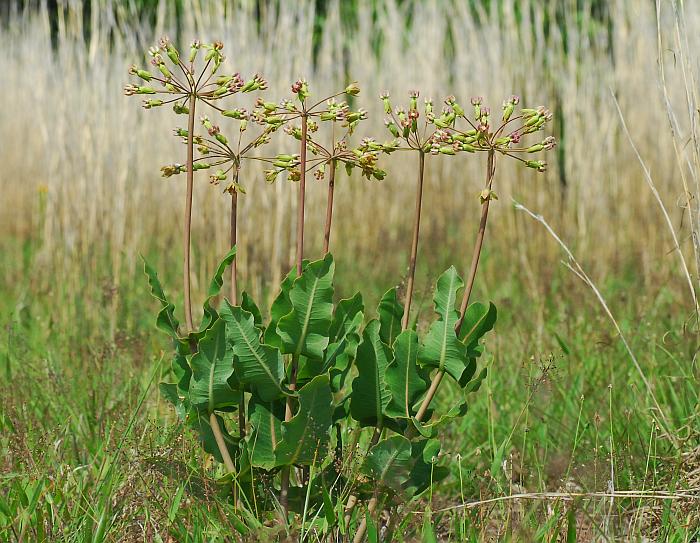Asclepias amplexicaulis Sm.
Sand Milkweed

Native
CC = 7
CW = 5
MOC = 24
© SRTurner
Asclepias amplexicaulis Sm.Sand Milkweed | |
 |
Native CC = 7 CW = 5 MOC = 24 |
© SRTurner |
|
Family - Asclepiadaceae Habit - Perennial herb from deeply set rhizomes. Stems - Erect, simple, single from the base, herbaceous but stout, to 1 m tall, 1.5 cm in diameter at the base, glabrous, glaucous, with copious milky sap when damaged.
Leaves - Opposite, sessile, clasping, spreading, typically 2-5 pairs below the inflorescence, thick, to 15 cm long, 8 cm broad, broadly oblong to oblong-ovate, glabrous, bases truncate to shallowly cordate and often overlapping the base of the opposite leaf, dark-green and glossy adaxially, light green and glaucous abaxially. Midrib lighter in color and contrasting with the leaf tissue. Lateral veins with a reddish tint, anastomosing before the leaf margin. Margins sinuate-crispate. Apex rounded to sub-acute, often with a mucro to 1 mm long.
Inflorescence - Single terminal umbel with 18-40 flowers. Pedicels to 4.5 cm long, +/-1mm in diameter, slightly expanded at the apex, puberulent to tomentose, often on only 1/2 or 2/3 of the circumference (the rest glabrous).
Flowers - Calyces 5-lobed, the lobes reflexed, glabrous, 3.0-5.5 mm long, lanceolate to narrowly ovate, hidden by the reflexed petals. Corolla lobes 5, reflexed, glabrous, green, often pink-tinged, 8-11 mm long, lanceolate to elliptic-lanceolate. Gynostegium appearing stalked (the column visible below the bases of the hoods), pink to pale orangish pink, the corona slightly longer than the tip of the anther/stigma head. Corona hoods 4.5-5.5 mm long, pinkish-purple, erect or strongly ascending, attached near their bases, oblong in outline, the tips broadly rounded to truncate, the bases slightly pouched. Horns attached near the hood bases, exserted and incurved over the anther/stigma head, linear. Pollinia 2-2.5 mm long. Anther sacs brownish-gold. Terminator purple, 0.5-0.6 mm long.
Fruits - Follicles 9-16 cm long, erect or ascending from usually deflexed stalks, narrowly lanceolate in outline, the surface smooth, glabrous, glaucous. Seeds with the body 6.5-9.0 mm long, the margins mostly narrowly winged, the terminal tuft of hairs white or more commonly light cream-colored. Flowering - April - July. Habitat - Upland prairies, sand prairies, glades, rocky open woods, roadsides, railroads. Origin - Native to the U.S. Lookalikes - None close. Other info. - This attractive species can be found in scattered throughout much of Missouri, but is not terribly common. Its natural range extends across most of the eastern half of the U.S. It can be easily identified by its erect, glabrous stems, sessile, clasping leaves, and pinkish flowers. The flowers typically occur in a single terminal inflorescence. The leaves have undulate-crispate margins and are rounded at the apex. As is the case with most of the milkweeds, injured parts of the plants will exude white milky sap. The plant favors sandy substrate. Photographs taken at Fort Benning, GA., 5-15-05 (DETenaglia); also at Sand Prairie Conservation Area, Scott County, MO, 5-21-2014 and 5-6-2020 (SRTurner). |